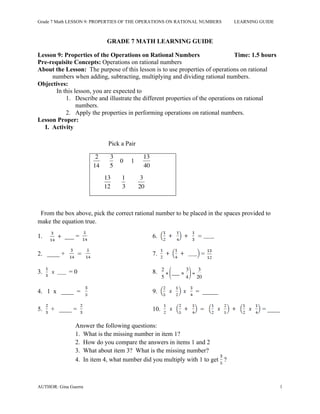Doc
- 1. Grade 7 Math LESSON 9: PROPERTIES OF THE OPERATIONS ON RATIONAL NUMBERS LEARNING GUIDE AUTHOR: Gina Guerra 1 GRADE 7 MATH LEARNING GUIDE Lesson 9: Properties of the Operations on Rational Numbers Time: 1.5 hours Pre-requisite Concepts: Operations on rational numbers About the Lesson: The purpose of this lesson is to use properties of operations on rational numbers when adding, subtracting, multiplying and dividing rational numbers. Objectives: In this lesson, you are expected to 1. Describe and illustrate the different properties of the operations on rational numbers. 2. Apply the properties in performing operations on rational numbers. Lesson Proper: I. Activity Pick a Pair Ōé¼ 2 14 Ōé¼ 3 5 0 1 Ōé¼ 13 40 Ōé¼ 13 12 Ōé¼ 1 3 Ōé¼ 3 20 From the box above, pick the correct rational number to be placed in the spaces provided to make the equation true. 1. ___ = 6. 2. ____ + 7. = 3. = 0 8. Ōé¼ 2 5 ├Ś ___ ├Ś 3 4 ŌÄø’Ż½ ŌÄØ’ŻŁ ŌÄ£’Ż¼ ŌÄ×’ŻČ ŌÄĀ’ŻĖ ŌĤ’ŻĘ = 3 20 4. 1 x ____ = 9. = _____ 5. + ____ = 10. = ____ Answer the following questions: 1. What is the missing number in item 1? 2. How do you compare the answers in items 1 and 2 3. What about item 3? What is the missing number? 4. In item 4, what number did you multiply with 1 to get ?
- 2. Grade 7 Math LESSON 9: PROPERTIES OF THE OPERATIONS ON RATIONAL NUMBERS LEARNING GUIDE AUTHOR: Gina Guerra 2 5. What number should be added to in item 5 to get the same number? 6. What is the missing number in items 6 and 7? 7. What can you say about the grouping in items 6 and 7? 8. What do you think are the answers in items 8 and 9? 9. What operation did you apply in item 10? Problem: Consider the given expressions: a. b. = * Are the two expressions equal? If yes, state the property illustrated. PROPERTIES OF RATIONAL NUMBERS (ADDITION & MULTIPLICATION) 1. CLOSURE PROPERTY: For any two rational numbers. , their sum and product is also rational. For example: a. = b. 2. COMMUTATIVE PROPERTY: For any two rational numbers , i. = ii. = where a, b, c and d are integers and b and d are not equal to zero. For example: a. b. 3. ASSOCIATIVE PROPERTY: For any three rational numbers i.
- 3. Grade 7 Math LESSON 9: PROPERTIES OF THE OPERATIONS ON RATIONAL NUMBERS LEARNING GUIDE AUTHOR: Gina Guerra 3 ii. where a, b, c, d, e and f are integers and b, d and f are not equal to zero. For example: a. b. 4. DISTRIBUTIVE PROPERTY of multiplication over addition for rational numbers. If are any rational numbers, then For example: 5. DISTRIBUTIVE PROPERTY of multiplication over subtraction for rational numbers. If are any rational numbers, then For example: 6. IDENTITY PROPERTY Addition: Adding 0 to a number will not change the identity or value of that number. + 0 = For example: Multiplication: Multiplying a number by 1 will not change the identity or value of that number. For example: 7. ZERO PROPERTY OF MULTIPLICATION: Any number multiplied by zero equals 0, i. e. For example: II. Question to Ponder (Post-Activity Discussion) Let us answer the questions posed in the opening activity.
- 4. Grade 7 Math LESSON 9: PROPERTIES OF THE OPERATIONS ON RATIONAL NUMBERS LEARNING GUIDE AUTHOR: Gina Guerra 4 1. What is the missing number in item1? ┬╗ 2. How do you compare the answers in items 1 and 2? ┬╗ The answer is the same, the order of the numbers is not important. 3. What about item 3? What is the missing number? ┬╗ The missing number is 0. When you multiply a number with zero the product is zero. 4. In item 4, what number did you multiply with 1 to get ? ┬╗ When you multiply a number by one the answer is the same. 5. What number should be added to in item 5 to get the same number? ┬╗ 0, When you add zero to any number, the value of the number does not change. 6. What do you think is the missing number in items 6 and 7?┬╗ 7. What can you say about the grouping in items 6 and 7? ┬╗ The groupings are different but they do not affect the sum. 8. What do you think are the answers in items 8 and 9? ┬╗ The answer is the same in both items, . 9. What operation did you apply in item 10? ┬╗ The Distributive Property of Multiplication over Addition III. Exercises: Do the following exercises. Write your answer in the spaces provided. A. State the property that justifies each of the following statements. 1. _________________________ 2. 1 = ____________________________ 3. ___________________ 4. ___________________________ 5. Ōé¼ 2 7 + 1 5 + 2 3( )ŌĆó1 = 2 7 + 1 5 + 2 3( ) ___________________________
- 5. Grade 7 Math LESSON 9: PROPERTIES OF THE OPERATIONS ON RATIONAL NUMBERS LEARNING GUIDE AUTHOR: Gina Guerra 5 6. ______________________________________ 7. Ōé¼ 1 2 + 5 6 = 4 3 _________________________________ 8. = _______________________ 9. Ōé¼ 1 4 ┬Ā ___________________________ 10. Ōé¼ 2 15 ŌĆó 5 7( )ŌĆó 0 = 0______________________________________ B. Find the value of N in each expression 1. N + 2. = 3. = + 4. 0 + N = 6. N = 7. 8. = N Summary This lesson is about the properties of operations on rational numbers. The properties are useful because they simplify computations on rational numbers. These properties are true under the operations addition and multiplication. Note that for the Distributive Property of Multiplication over Subtraction, subtraction is considered part of addition. Think of subtraction as the addition of a negative rational number.





